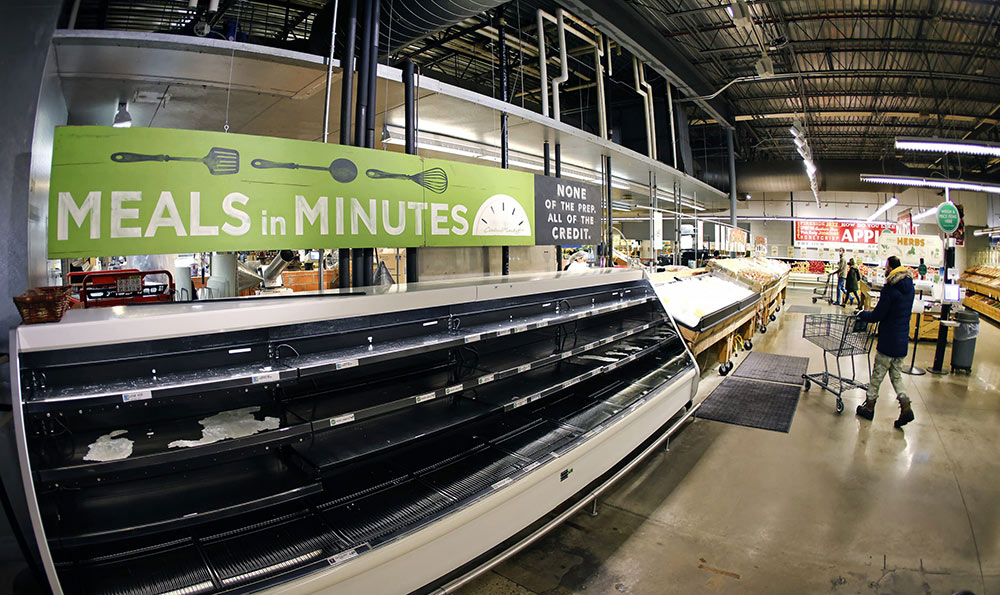
得州電網斷電、密歇根州飲用水污染、明尼那波利斯大橋倒塌,這些案例真實或形象地說明,美國基礎設施已經達到了其承受能力的極限。
這些并非是孤立的問題,而是讓美國及其經濟倍感壓力的系統性故障。隨著國家經濟實力的衰敗,人們將失去其生活和生計。
然而好消息在于,解決全美基礎設施問題,無論從短期還是從更重要的長期來講,都將有利于經濟的發展。美國經濟過去之所以強大是因為我們有良好的基礎設施。如今,美國經濟依賴的是其競爭力,而不是其基礎設施。
改善基礎設施是少數能夠在美國公眾中獲得兩黨支持的事項之一。80%的美國民眾對美國基礎設施重建表示支持,這一比例高于人們對美國其他任何重大問題的共識,而且約三分之二的美國人認為其所在地區道路的路況一般或很差。同時,還有類似比例的美國民眾認為美國在滿足基礎設施需求方面做得還不夠到位。
改善基礎設施也是一項復雜的挑戰,涉及眾多利益相關方。例如,聯邦政府和各州負責高速公路建設和維護;當地政府負責水和下水道基礎設施;互聯網通訊則由私營公司負責。與此同時,大量的預算赤字也讓這些政府無力投資、維護和翻修基礎設施。
如何實現基礎設施的現代化,并保持其良好的狀態,才可以讓經濟變得強大并不斷增長?我們在下文列舉了一些頗具全面性、財政可持續性和成本效益,而且將獲得兩黨支持的基礎設施項目關鍵組件。
首先,改革監管機制。經過合理制定法規能夠促進競爭,而且反過來將有助于以最低的成本獲得最好的基礎設施。精簡監管流程,削減聯邦、州和當地政府的繁文縟節,對于提升投資、減少成本和實現效率最大化有著重要作用。
嚴格的成本效益分析對于任何智能監管機制來說至關重要。建造和維修活動的競爭性投標亦十分重要。聯邦政府可以提供技術專長,但我們也需要有關當地實際成本和效益的信息。
第二,進行戰略思考。我們需要以長遠眼光進行投資,而這意味著讓美國回歸可持續的財政道路,此舉將為持續的投資創造更多的空間。
從長遠角度思考還意味著確保維護和翻修能夠在收益和成本方面與項目重建競爭所需的資金。電力行業需要可靠性,要求具備一定的余量和過剩容量,以及對電網和輸送網絡的嚴格評估和維護。投資開發更好的電池技術十分重要。
基礎設施決策還必須考慮不斷發展的科技,例如無人駕駛車輛和不斷發展的數字通訊技術。我們有必要對基礎設施投資科技進行研究(例如更耐用的高速公路,鋪設厚度更厚,或將捕捉的碳嵌入混凝土),以改善生產力、降低成本,并保護環境。高品質的寬帶已經成為市民和實現公平機會的必需品。我們必須考慮長期風險,例如氣候風險和韌性。
第三,明智決策,并對財政負責。基礎設施往往涉及多個試圖實施刻板解決方案的參與者。聯邦、州和當地決策者(包括跨州和跨地區)必須在項目審批期間通過更好地協調來避免重復和延遲,比如495號州際公路伍德羅威爾森大橋(Interstate 495 Woodrow Wilson Bridge)翻修工程,該橋橫跨馬里蘭州和弗吉尼亞州之間的波托馬克河,但因為多重評估而進展緩慢。
與此同時,決策者們需要為每個獨特的項目選擇最佳的資助工具,包括探索替代方式,從而使用私人投資資源。在適合開展公私合營的項目中(僅適用于某些基礎設施),他們可以用于補充公共專長和資源。
我們必須以可持續的方式來使用高速公路信托基金。在短期內,這意味著提升燃油稅。從更長遠來看,它面臨著巨大的資金挑戰,因為社會正在轉而使用并不含有當前燃油稅的可再生燃料。
以上只是構成良好基礎設施項目的一些組件,但其廣泛的涉及范圍凸顯了我們面臨的挑戰的難度。這要求全美上下協調一致、同心協力。是時候了,政策領導者和其他決策者應該鋪好道路,讓美國再次踏上征程。(財富中文網)
杰克·霍克瑪是Kaiser Aluminum公司董事長。
維基·珀珀尼是美國本田汽車公司前任客戶數字旅程業務副總裁。
內森·羅森博格是Insigniam公司創始合伙人。
本文作者是世界大型企業聯合會經濟發展委員會董事,及其基礎設施委員會的聯席主席。
譯者:馮豐
審校:夏林
得州電網斷電、密歇根州飲用水污染、明尼那波利斯大橋倒塌,這些案例真實或形象地說明,美國基礎設施已經達到了其承受能力的極限。
這些并非是孤立的問題,而是讓美國及其經濟倍感壓力的系統性故障。隨著國家經濟實力的衰敗,人們將失去其生活和生計。
然而好消息在于,解決全美基礎設施問題,無論從短期還是從更重要的長期來講,都將有利于經濟的發展。美國經濟過去之所以強大是因為我們有良好的基礎設施。如今,美國經濟依賴的是其競爭力,而不是其基礎設施。
改善基礎設施是少數能夠在美國公眾中獲得兩黨支持的事項之一。80%的美國民眾對美國基礎設施重建表示支持,這一比例高于人們對美國其他任何重大問題的共識,而且約三分之二的美國人認為其所在地區道路的路況一般或很差。同時,還有類似比例的美國民眾認為美國在滿足基礎設施需求方面做得還不夠到位。
改善基礎設施也是一項復雜的挑戰,涉及眾多利益相關方。例如,聯邦政府和各州負責高速公路建設和維護;當地政府負責水和下水道基礎設施;互聯網通訊則由私營公司負責。與此同時,大量的預算赤字也讓這些政府無力投資、維護和翻修基礎設施。
如何實現基礎設施的現代化,并保持其良好的狀態,才可以讓經濟變得強大并不斷增長?我們在下文列舉了一些頗具全面性、財政可持續性和成本效益,而且將獲得兩黨支持的基礎設施項目關鍵組件。
首先,改革監管機制。經過合理制定法規能夠促進競爭,而且反過來將有助于以最低的成本獲得最好的基礎設施。精簡監管流程,削減聯邦、州和當地政府的繁文縟節,對于提升投資、減少成本和實現效率最大化有著重要作用。
嚴格的成本效益分析對于任何智能監管機制來說至關重要。建造和維修活動的競爭性投標亦十分重要。聯邦政府可以提供技術專長,但我們也需要有關當地實際成本和效益的信息。
第二,進行戰略思考。我們需要以長遠眼光進行投資,而這意味著讓美國回歸可持續的財政道路,此舉將為持續的投資創造更多的空間。
從長遠角度思考還意味著確保維護和翻修能夠在收益和成本方面與項目重建競爭所需的資金。電力行業需要可靠性,要求具備一定的余量和過剩容量,以及對電網和輸送網絡的嚴格評估和維護。投資開發更好的電池技術十分重要。
基礎設施決策還必須考慮不斷發展的科技,例如無人駕駛車輛和不斷發展的數字通訊技術。我們有必要對基礎設施投資科技進行研究(例如更耐用的高速公路,鋪設厚度更厚,或將捕捉的碳嵌入混凝土),以改善生產力、降低成本,并保護環境。高品質的寬帶已經成為市民和實現公平機會的必需品。我們必須考慮長期風險,例如氣候風險和韌性。
第三,明智決策,并對財政負責。基礎設施往往涉及多個試圖實施刻板解決方案的參與者。聯邦、州和當地決策者(包括跨州和跨地區)必須在項目審批期間通過更好地協調來避免重復和延遲,比如495號州際公路伍德羅威爾森大橋(Interstate 495 Woodrow Wilson Bridge)翻修工程,該橋橫跨馬里蘭州和弗吉尼亞州之間的波托馬克河,但因為多重評估而進展緩慢。
與此同時,決策者們需要為每個獨特的項目選擇最佳的資助工具,包括探索替代方式,從而使用私人投資資源。在適合開展公私合營的項目中(僅適用于某些基礎設施),他們可以用于補充公共專長和資源。
我們必須以可持續的方式來使用高速公路信托基金。在短期內,這意味著提升燃油稅。從更長遠來看,它面臨著巨大的資金挑戰,因為社會正在轉而使用并不含有當前燃油稅的可再生燃料。
以上只是構成良好基礎設施項目的一些組件,但其廣泛的涉及范圍凸顯了我們面臨的挑戰的難度。這要求全美上下協調一致、同心協力。是時候了,政策領導者和其他決策者應該鋪好道路,讓美國再次踏上征程。(財富中文網)
杰克·霍克瑪是Kaiser Aluminum公司董事長。
維基·珀珀尼是美國本田汽車公司前任客戶數字旅程業務副總裁。
內森·羅森博格是Insigniam公司創始合伙人。
本文作者是世界大型企業聯合會經濟發展委員會董事,及其基礎設施委員會的聯席主席。
譯者:馮豐
審校:夏林
A failing power grid in Texas, poisonous drinking water in Flint, Mich., a bridge collapse in Minneapolis: Such examples illustrate the literal and figurative breaking point America’s infrastructure has reached.
These are not isolated problems, but a system failure that compounds the stresses on the country and its economy. Lives and livelihoods are lost as the nation’s economic strength is sapped.
The good news, though, is that addressing the national infrastructure will have salutary economic effects in both the short term and, more important, the long term. The U.S. economy used to be strong because of our infrastructure. Now, the U.S. economy hangs on to competitiveness despite our infrastructure.
Improving infrastructure is one of the few issues that enjoys strong bipartisan support among the American public. Eighty percent of Americans support rebuilding our nation’s infrastructure—more agreement than on almost any other top issue facing the nation—and roughly two-thirds of Americans rate their own local roads as in fair or poor condition. A similar proportion say that the country is not doing enough to meet infrastructure needs.
Improving infrastructure is a complex challenge involving many stakeholders. The federal government and states, for example, handle highway construction and maintenance; localities are responsible for water and sewer infrastructure; Internet communications are handled by private interests. All the while, huge budget deficits make investing in and repairing and renewing infrastructure look unaffordable.
How can we modernize our infrastructure, and keep it sound, so that our economy is strong and growing? Here are critical components of a bipartisan, comprehensive, cost-efficient, and fiscally sustainable infrastructure program:
First, reform the regulatory regime. Properly instituted, regulation can promote competition, which in turn will help us get the best infrastructure at the least cost. Streamlining regulatory procedures and cutting red tape across federal, state, and local governments is key to increasing investment, decreasing cost, and maximizing efficiency.
Rigorous cost-benefit analysis is essential to any smart regulatory scheme. Competitive bidding for construction and maintenance are essential. The federal government can provide technical expertise, but locally based, on-the-ground input regarding both costs and benefits is needed as well.
Second, think strategically. We need to invest for the long term, and that means putting ourselves on a sustainable fiscal course, which will create more room for enduring investment.
Thinking for the long term also means ensuring that maintenance and renewal compete with new construction for infrastructure dollars on the basis of benefits and costs. The electricity sector needs reliability, which requires some redundancy and excess capacity, along with rigorous evaluation and maintenance of the power grid and distribution network. Investing in developing better battery technology is essential.
Infrastructure decisions must also anticipate evolving technologies such as autonomous vehicles and advancing digital communications. Research into infrastructure investment technology (such as longer-lasting highways with thicker paving or embedding captured carbon in concrete) will be needed to improve productivity, reduce costs, and protect the environment. Access to quality broadband has become a necessity of citizenship and equal opportunity. And we must account for long-term risks, such as climate risk and resilience.
Third, act smartly and in a way that is fiscally responsible. Too often infrastructure involves a multitude of actors trying to implement inflexible solutions. Federal, state, and local decision-makers (including across states and localities) must better coordinate to avoid duplication and delay during project approvals. A multistate, multi-local jurisdiction project—such as the Interstate 495 Woodrow Wilson Bridge renewal across the Potomac between Maryland and Virginia—was slowed by multiple reviews.
At the same time, policymakers need to select the best funding tool for each unique project, including exploring alternative approaches for utilizing private investment resources. Where public-private partnerships are appropriate—which is for only some infrastructure—they can supplement public expertise and resources.
The Highway Trust Fund must be put on sustainable footing. In the short run, that will require increases in the fuel tax. The longer term poses significant funding challenges, assuming a continuing shift toward renewable fuels that do not bear the current fuel tax.
These are just some components of a sound infrastructure program, but their sheer breadth illustrates the magnitude of the challenge we face. It requires a coordinated, all-hands national response. It is now time for policy leaders and other decision-makers to apply the rubber to the road and get us moving again.
Jack Hockema is executive chairman of Kaiser Aluminum.
Vicki Poponi is former vice president of digital customer journey at American Honda Motor Co.
Nathan O. Rosenberg is founding partner of Insigniam.
The authors are trustees of the Committee for Economic Development of the Conference Board and cochair its Infrastructure Committee.






